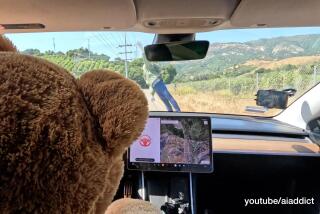Ford to launch new Sync infotainment system to address complaints
- Share via
Ford Motor Co. is moving to address one of the biggest complaints about its vehicles — the glitchy in-dash Sync technology system that controls such things as temperature settings, phone calls and music selection.
The new system is a complete redesign that Ford engineers say is faster, more intuitive and easier to use.
Ford said Thursday that it will introduce Sync 3 in its new Ford and Lincoln cars, starting with the 2016 model year. Almost all new models are expected to have the new system by the 2017 model year. It also is dropping the MyFord Touch portion of the system’s name.
The complexity and unreliability of the technology has plagued Ford since it introduced the system in 2007 and contributed to a below-average rating for the automaker in this year’s U.S. Vehicle Dependability Study from J.D. Power.
Technology troubles have also become the biggest consumer complaint across the industry, according to another J.D. Power report.
The biggest source of problems are built-in voice-recognition systems, which Ford said it has improved in the new system.
Although Sync 3 will have the capacity to take Wi-Fi updates just like a smartphone or tablet, Ford won’t be able to upgrade older vehicles.
Ford already has made some reliability improvements to existing versions of Sync, said Thomas Mutchler, the vehicle interface program manager at Consumer Reports.
“Thanks to this, products like the Taurus and Explorer moved to average reliability in our survey,” Mutchler said.
But to make Sync competitive with the best in-dash systems from other automakers, Ford needs to have larger on-screen fonts, simpler screens with fewer options, make the function of controlling the radio or phone easier and add some normal buttons and knobs, Mutchler said
That is exactly what Ford is doing with Sync 3, said Parrish Hanna, Ford’s global director of human machine interface. Ford reviewed 22,000 comments and suggestions during the redesign.
The bottom line: Consumers want a stable system that operates more like a phone or tablet, he said.
Improving the logic that controls voice recognition was a major focus of the redesign.
The system has a better understanding of what drivers are asking for. Previously, the driver would have to ask the computer to play music and then name the artist. Now, Hanna said, you can say, “Play Katy Perry,” and it will put her on — rather than try to call her on the phone.
Similarly, you will be able to say, “Find P.F. Chang’s” rather than the exact name, “P.F. Chang’s China Bistro,” and the navigation will take you to the nearest restaurant in the chain.
Hanna said the new Sync understands the different ways people describe things. For example, you can ask for an address at “eleven-forty-five Main Street” rather than spelling out “one-one-four-five.”
Other irritants tackled by Ford engineers: Now if the driver has the music screen displayed when turning off the car, that screen pops back up when the vehicle is started again. It doesn’t default back to a home screen. Font sizes are larger, and the system uses a light sensor to adjust screen lighting to deal with glare or darkness.
The touch points on the screen are more accurate so drivers are less likely to call up a function they don’t want. There are also more mechanical buttons to use as alternate controls.
As it designed the new system, Ford found that what controls people wanted to use varied by function.
“When you ask people to change the temperature, most look for a dial to turn,” Hanna said. “But when you ask them to play music, they look at the screen first. That comes from using iPods and iPads and Pandora and other music services.”
Ford reduced complexity in the system by having the interface prioritize the options customers use most. The home screen has three zone choices: Navigation, Audio and Phone. Easy-to-read, tile-like icons dominate the screen. Phone contacts can be searched with finger swipes.
“We considered all the modern smartphones and mobile operating systems and created something familiar but unique,” Hanna said.
After some missteps, Ford is now on track with its technology strategy, said Mark Boyadjis, an analyst at IHS Automotive.
“Ford has put in the time and listened to enough customers to properly design, test, debug, and finalize this infotainment platform before it hits the market,” Boyadjis said.
A brief test of the Sync 3 revealed the system to be more intuitive and responsive, he said.
“Ford’s next challenge is to get this into production,” Boyadjis said, “and possibly retake some top spots in terms of customer acceptance and satisfaction.”
Follow me on Twitter (@LATimesJerry), Facebook and Google+.







